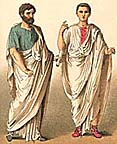 The toga, the principal outer garment worn by the Romans, is derived by Varro from tegere, because it covered the whole body (v.144, ed. Müller).
The toga, the principal outer garment worn by the Romans, is derived by Varro from tegere, because it covered the whole body (v.144, ed. Müller).
Gellius (vii.12) states that at first it was worn alone, without the tunic. [TUNICA.] Whatever may have been the first origin of this dress, which some refer to the Lydians, it seems to have been received by the Romans from the Etruscans, for it is seen on Etruscan works of art as the only covering of the body, and the toga praetexta is expressly said to have been derived from the Etruscans (Liv. i.8; Plin. H.N. viii.48 s74; Müller, Etrusker, vol.1 p262).
Gradually, colours began to distinguish class and professions:
blue for philosophers
black for theologians
green for practitioners of the medical arts.
Soothsayers wore an unornamented white toga.
Peasants were allowed only one sober colour.
Officers were allowed garments of two colours
Clan commanders could wear three colours
Members of the Imperial household wore as as many as seven colours.
(Becker, Gallus, vol.ii pp78-88; Ferrarius, de Re Vestiaria; Rubenius, de Re Vest.)
Article by Philip Smith, B.A., of the University of London on pp1134-1137 of William Smith, D.C.L., LL.D.: A Dictionary of Greek and Roman Antiquities, John Murray, London, 1875.
No comments:
Post a Comment